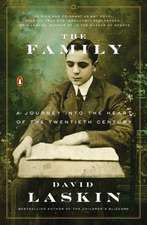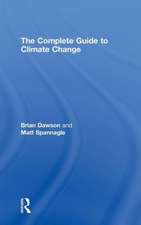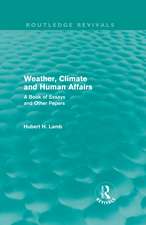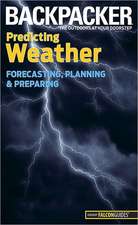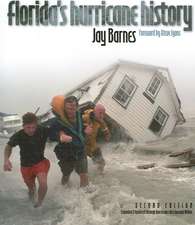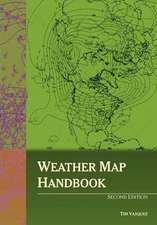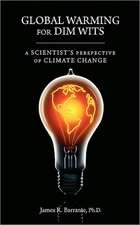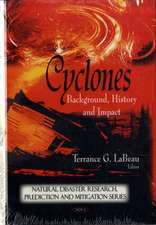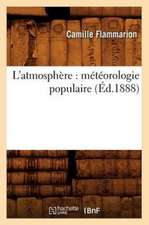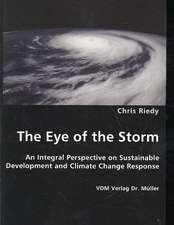Braving the Elements
Autor David Laskin, Letty Pogrebinen Limba Engleză Paperback – 31 mai 1997
Since before Columbus, the peoples of America have struggled to make sense of the capricious and violent nature of America's weather. Anasazi Indians used the rain dance (and sometimes human sacrifice) to induce rain, while the Puritans in New England blamed the sins of the community for lightening strikes and Nor'easters. IN modern times we carry on those traditions by blaming the weatherman for ruined weekends. Despite hi-tech satellites and powerful computers and 24-hour-a-day forecasting from The Weather Channel, we're still at the mercy of the whims of Mother Nature.
Laskin recounts the many dramatic moments in American weather history, from the "Little Ice Age" to Ben Franklin's invention of the lightning rod to the Great Blizzard of the 1930's to the worries about global warming. Packed with fresh insights and wonderful lore and trivia, Braving the Elements is unique and essential reading for anyone who's ever asked, "What's it like outside?"
From the Hardcover edition.
Preț: 101.14 lei
Nou
Puncte Express: 152
Preț estimativ în valută:
19.36€ • 20.13$ • 15.98£
19.36€ • 20.13$ • 15.98£
Carte disponibilă
Livrare economică 24 martie-07 aprilie
Preluare comenzi: 021 569.72.76
Specificații
ISBN-13: 9780385469562
ISBN-10: 038546956X
Pagini: 272
Dimensiuni: 133 x 202 x 16 mm
Greutate: 0.23 kg
Editura: Anchor Books
ISBN-10: 038546956X
Pagini: 272
Dimensiuni: 133 x 202 x 16 mm
Greutate: 0.23 kg
Editura: Anchor Books
Extras
Every forecaster who works for the National Weather Service has a story about when he or she got the call. It almost always happened in childhood, usually between the ages of seven and ten. A tornado veered off just before it totaled their home. Lightning hit a tree across the street and they wanted to know why. Their dad got stranded by a hurricane. "The next day I knew I wanted to be a weatherman," one forecaster told me after recounting his tale of how a tornado whipped up I "just scared the devil out of me" when he was a ten-year-old boy in Texas. "And I never changed my mind from that time on." When you spend time around National Weather Service meteorologists, you hear a lot versions of this story, but the conclusion is always the same: I never changed my mind from that day on. Lifelong commitment, insatiable curiosity, inexhaustible excitement over the weather: these are passions that motivate the people in charge of our national weather. These folks are not dull gray bureaucrats marking time in cinder-block Washington offices. They are people who have been obsessed for as long as they can remember with the weather--what causes it to change, how to predict those changes, how to communicate the predictions to as many people as quickly as possible. "We are all weather nuts," confessed one NWS meteorologist with some pride. Even when we're off duty, we're very conscious of what's going on in the weather. We're always aware of what's going on out there."
Spend some more time around the NWS folks, really get them talking about what they do and why they do it for the government instead of for some television station or private weather company, and you learn that underneath the weather obsession is a real sense of mission. For them, the bottom line is us--our lives, our property, our safety. "I don't care if I get an attribution or not on the Weather Channel," says Ed Gross, the NWS chief of industrial meteorology (which means the liaison between the NWS and commercial weather operations such as Accu-Weather or the Weather Channel). "If they say 72 degrees and I say 83, I don't care. If the guy gets on the air and says, 'Here's my forecast,' when it's really the NWS forecast--I don't care. What concerns me is warnings. Making sure that the warnings go out, that they're consistent, that the public is aware and not confused or misled." Or as the government document entitled Operations of the National Weather Service states grandly under the heading "Objective": "To contribute to the safety, health, welfare, comfort, and convenience of the public, and to meet the needs of all segments of the national economy for general weather information."
Which is not to say that the NWS meteorologists don't get a tremendous charge out of the weather--the more intense, the better. Predicting whether tomorrow will be partly or variably cloudy; whether the ridge of high pressure over New England will drift east or east-northeast: totally routine. It's the severe weather--the blizzards, hurricanes, tornadoes, flash floods-- that brings out the best in these people. There's a funny paradox at the heart of the career of a NWS meteorologist: your mission is to keep people from being killed by the very weather that you live for. It's a bit like a detective with a serial murder or a terrorist bomb plot. Disaster gives meaning to the job.
The lives of a great many NWS meteorologists were saturated with meaning on the weekend of March 13, 1993. This was the weekend when the Storm of the Century--the Superstorm of 1993 that appears in the opening pages of this book--hit the eastern corridor of the United States, dumping unprecedented quantities of snow from Alabama to Maine. Half the population of the country suffered through the storm; over two hundred people died in it or because of it. "The Superstorm of March 12-14, 1993, was among the greatest non-tropical weather events to affect the nation in modern times," notes the Natural Disaster Survey Report on the storm. "The Superstorm adversely impacted over 100 million citizens during its lifetime and severely crippled economic activities in the eastern-third of the U.S." Yet for people inside the NWS, March 13, 1993, is a red-letter day, one they will long remember with pride, even exultation. For this was a weather disaster in which everything came together for new, improved NWS--mathematics, physics, technology, communications, media relations. "It was a defining moment in our forecast process," says Dr. Louis Uccellini, who was then serving as chief of the Meteorology Operations Division (MOD) of the National Meteorological Center and has since been promoted to the position of director of the Center of Meteorology at the National Weather Service, "a process that has evolving over the past forty years." Dr. Uccellini should know. He literally wrote the book on winter storms--Snowstorms Along the Northeast of the United States, 1955-1985, co-authored with Paul Kocin.
Clearly, there will have to be a new edition.
When I went down to Washington to find out how the NWS produces our nation's weather forecasts, it was the middle of May, only two months after the great blizzard, but already a glaring heat wave dulled the city. The foot-and-a-half of snow had soaked into the earth and evaporated the weepy Washington humidity, but the "defining moment" of the storm was still fresh in everybody's mind, perhaps freshest of all in the mind of Lou Uccellini. Uccellini and his colleagues at every level of the National weather pyramid were only too happy to talk about--indeed, to play by play--one of their greatest forecasting triumphs. Weather, of course, does not stop, and since the March '93 Superstorm there have been many other weather disasters--floods, tornadoes, hurricanes--some forecast triumphantly, others not. The next winter--1993 to 1994--whacked the East Coast with a whole series of snowstorms and icestorms, none of them as stupendous as the Superstorm, but all of them together adding up to one of the harshest winters in memory. But even so, the Superstorm remains a "defining moment" in Weather Service history and as such provides a good window through which to view the entire system.
Spend some more time around the NWS folks, really get them talking about what they do and why they do it for the government instead of for some television station or private weather company, and you learn that underneath the weather obsession is a real sense of mission. For them, the bottom line is us--our lives, our property, our safety. "I don't care if I get an attribution or not on the Weather Channel," says Ed Gross, the NWS chief of industrial meteorology (which means the liaison between the NWS and commercial weather operations such as Accu-Weather or the Weather Channel). "If they say 72 degrees and I say 83, I don't care. If the guy gets on the air and says, 'Here's my forecast,' when it's really the NWS forecast--I don't care. What concerns me is warnings. Making sure that the warnings go out, that they're consistent, that the public is aware and not confused or misled." Or as the government document entitled Operations of the National Weather Service states grandly under the heading "Objective": "To contribute to the safety, health, welfare, comfort, and convenience of the public, and to meet the needs of all segments of the national economy for general weather information."
Which is not to say that the NWS meteorologists don't get a tremendous charge out of the weather--the more intense, the better. Predicting whether tomorrow will be partly or variably cloudy; whether the ridge of high pressure over New England will drift east or east-northeast: totally routine. It's the severe weather--the blizzards, hurricanes, tornadoes, flash floods-- that brings out the best in these people. There's a funny paradox at the heart of the career of a NWS meteorologist: your mission is to keep people from being killed by the very weather that you live for. It's a bit like a detective with a serial murder or a terrorist bomb plot. Disaster gives meaning to the job.
The lives of a great many NWS meteorologists were saturated with meaning on the weekend of March 13, 1993. This was the weekend when the Storm of the Century--the Superstorm of 1993 that appears in the opening pages of this book--hit the eastern corridor of the United States, dumping unprecedented quantities of snow from Alabama to Maine. Half the population of the country suffered through the storm; over two hundred people died in it or because of it. "The Superstorm of March 12-14, 1993, was among the greatest non-tropical weather events to affect the nation in modern times," notes the Natural Disaster Survey Report on the storm. "The Superstorm adversely impacted over 100 million citizens during its lifetime and severely crippled economic activities in the eastern-third of the U.S." Yet for people inside the NWS, March 13, 1993, is a red-letter day, one they will long remember with pride, even exultation. For this was a weather disaster in which everything came together for new, improved NWS--mathematics, physics, technology, communications, media relations. "It was a defining moment in our forecast process," says Dr. Louis Uccellini, who was then serving as chief of the Meteorology Operations Division (MOD) of the National Meteorological Center and has since been promoted to the position of director of the Center of Meteorology at the National Weather Service, "a process that has evolving over the past forty years." Dr. Uccellini should know. He literally wrote the book on winter storms--Snowstorms Along the Northeast of the United States, 1955-1985, co-authored with Paul Kocin.
Clearly, there will have to be a new edition.
When I went down to Washington to find out how the NWS produces our nation's weather forecasts, it was the middle of May, only two months after the great blizzard, but already a glaring heat wave dulled the city. The foot-and-a-half of snow had soaked into the earth and evaporated the weepy Washington humidity, but the "defining moment" of the storm was still fresh in everybody's mind, perhaps freshest of all in the mind of Lou Uccellini. Uccellini and his colleagues at every level of the National weather pyramid were only too happy to talk about--indeed, to play by play--one of their greatest forecasting triumphs. Weather, of course, does not stop, and since the March '93 Superstorm there have been many other weather disasters--floods, tornadoes, hurricanes--some forecast triumphantly, others not. The next winter--1993 to 1994--whacked the East Coast with a whole series of snowstorms and icestorms, none of them as stupendous as the Superstorm, but all of them together adding up to one of the harshest winters in memory. But even so, the Superstorm remains a "defining moment" in Weather Service history and as such provides a good window through which to view the entire system.
Descriere
"An animated and absolutely fascinating history of our weather and our interpretations of it" ("Booklist"), "Braving the Elements" is filled with unforgettable stories of hurricanes, blizzards, droughts, and other extremes of weather which have taken place in America over the centuries. of photos.
Notă biografică
David Laskin



